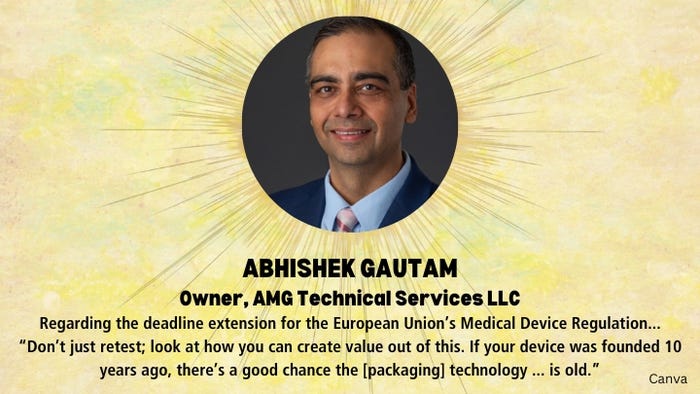What Does the EU MDR Extension Mean for Packaging?
The European Union’s latest extension of the Medical Device Regulation transitional period gives medical device packagers the opportunity to create better, safer products.

At a Glance
- Staggered compliance deadline extension from 2024 to 2027/2028 aims to prevent shortages of critical medical devices
- MDM expert recommends you consider redesign over retesting
- Extension provides time to enhance packaging safety, design, and shelf life
An amendment to the European Union’s Medical Device Regulation (EU MDR) extended the compliance date for legacy medical devices. The deadline of May 26, 2024, has been postponed to either 2027 or 2028, depending on the medical device risk class. For example, high-risk devices are subject to a shorter transition period ending in 2027, while low- to medium-risk devices have until the end of 2028 to complete conformity assessments.
Factors leading to the latest extension include the impacts of COVID-19 and the shortage of EU notified bodies, which in turn caused roadblocks for medical device manufacturers’ (MDMs) certification efforts. As a result, the EU introduced a staggered extension to mitigate the risk of lifesaving medical device shortages.
Abhishek Gautam, previously Director of Global Packaging for Teleflex Medical and now Owner, AMG Technical Services LLC, says that the most obvious benefit of the extension for packagers is that they now have time to start filling any existing compliance gaps — whether they relate to material safety, package design, or shelf life, to name a few. Although the deadline extension buys MDMs more time to retest products, he warns that if the product fails to meet the regulation when it is retested, it will result in a recall.
“This is still a big dilemma for MDMs,” he notes. “Now they have time to retest, but if they fail they have to pull their product from the market and get into that frenzy of trying to put a fix together.”
The case for redesign.
Instead of retesting, Gautam urges MDMs to consider redesigning their devices and packaging to create a better, safer product.

“I’m a strong proponent of this,” he says. “Don’t just retest; look at how you can create value out of this. If your device was founded 10 years ago, there’s a good chance the technology you’re using for creating the packaging is old. Your materials are probably outdated, your sterilization method may be ineffective, and maybe your design configurations are not optimized.”
With a three- to four-year extension, Gautam argues that packaging engineers now have time to improve on their existing packaging and create new designs from scratch.
One of EU MDR’s biggest impacts on packaging and labeling has been its focus on usability and patient safety. In fact, according to Gautam, over the last five years there has been a lot of pressure on medical device companies to improve the user experience. As a result, he believes that the extension offers MDMs a valuable opportunity to focus on usability and innovation, which in turn will give them a competitive advantage.
Gautam identifies another MDR packaging challenge: Labels and instructions for use (IFUs) have increased in size while the package size has stayed the same.
“Now we have the time to fix that,” he says. “And while we’re doing that, let’s optimize it and make it more cost-effective, sustainable, safer, and better for our users.”
Seeing the big picture behind the EU MDR extension.
Gautam recognizes that MDMs are caught up in making revenue and selling products and don’t often take a step back to look at the big picture.
“Don’t look at the short-term gain; look at the long-term process of building equity,” he advises. “These opportunities — especially the extension — are strategic advantages to become a better company. Ultimately, whoever takes the high-level stance and makes end-to-end improvements is going to be the real winner in the industry.”
About the Author(s)
You May Also Like




